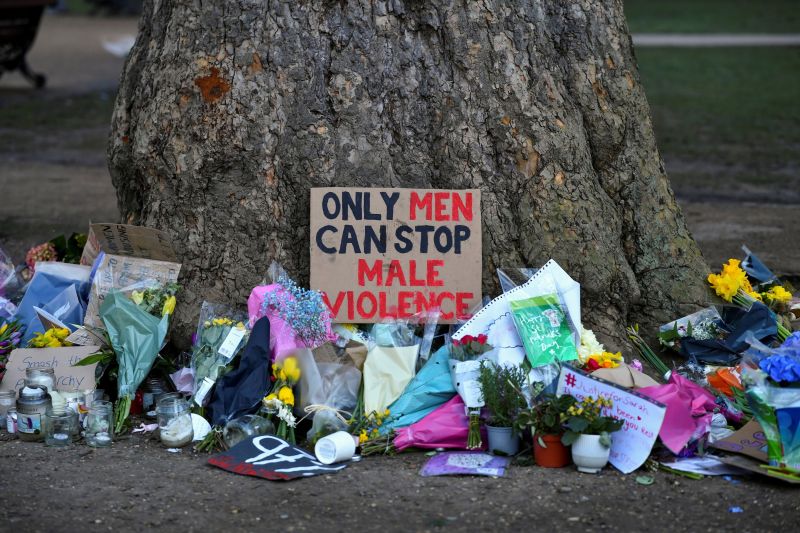
Something very peculiar is happening in Britain. There is a newly visible toxicity in its institutions, particularly the police and the army. If it was lurking beneath the surface before, now it has emerged, a rough beast slouching into the light. The beast is misogyny, a wave of which has gripped our news cycle with appalling force, part-eclipsing even the COP26 climate conference.
In the past week in London, two Metropolitan Police officers admitted photographing the bodies of two sisters, Bibaa Henry and Nicole Smallman, murdered in a park last year while celebrating a birthday. The officers superimposed their own heads onto those of the victims, and shared their creations on WhatsApp with 42 colleagues.
The Met police commissioner, Cressida Dick, called the officers “utterly unprofessional, disrespectful and deeply insensitive,” somehow missing the point: It was far worse than that. It was dehumanization; that most sinister gateway to untold cruelty in society.
This occurs at a time when the Met’s reputation was already in crisis after an officer’s kidnapping, rape and murder last March of 33-year-old marketing executive Sarah Everard.
It later emerged that his workplace nickname had been “the rapist”; that he had been arrested, and released, for indecent exposure days earlier and allowed to remain on duty. A fellow officer “joked” about the abduction in a police WhatsApp group, sharing a meme with images of an officer abducting a woman.
Isolated incidents? Hardly. A staggering 771 Met police employees — 88 percent of them officers, and 89 percent of them male — have been accused of sexual misconduct alone since 2010. Only 83 cases led to dismissal.
“The police are the public, and the public are the police,” wrote Sir Robert Peel, founder of the Metropolitan Police in London, when he laid down the British tradition of “policing by consent” in 1829. Well, not any more.
Even so, it was shocking last spring when a vigil in Everard’s memory was broken up by police with an aggression they notably hadn’t brought to other demonstrations in London violating pandemic restrictions. The Met’s own inspectorate found that the force had “acted appropriately.”
The ruling only fed the terrible sense here of an emerging culture war — a lack of comprehension of the misogyny problem, as if it were some kind of lack of manners, just a little unfortunate, or nonexistent.
And that is just the police. In the past week, Defense Secretary Ben Wallace called in army leadership to discuss conduct in the British forces. Revulsion has followed news that a British soldier allegedly murdered a 21-year-old Kenyan woman in 2012 and dumped her body in a septic tank. A fellow soldier told the Sunday Times what he had witnessed; no one had been charged, but now Kenyan police are reopening their investigation. The paper reported that many in the regiment knew what happened, and again came the wretched “jokes” about a woman’s death — laughing emoji and the like, this time on Facebook.
Also at issue for the British military are charges that a female officer cadet who committed suicide in 2019 had been sexually harassed. Last month, a report by BJM Military Health found that 22.5 percent of women veterans reported having been sexually harassed, and 5 percent sexually assaulted.
Army and police: Part of a wider surge of misogyny in society at large, or ecosystems with their own viral load? Possibly both. With a volatile combination of social media, an inadequate education system that bypasses ethics entirely, and some kind of backlash to identity politics and #MeToo that has left some men, possibly those in the most “male” of professions, feeling emasculated and belittled (which is not to excuse anyone), there are signs that the scourge is more widespread.
Earlier this year came #EveryonesInvited, an online campaign that thundered against “rape culture” in British schools, including the elite private sector. (Girls sent in anonymous accounts of how they had been mistreated.) This fall, female students at several universities report an outbreak of “spiking” — being surreptitiously drugged with needle jabs in nightclubs or at parties. Victims complained that neither the police nor the National Health Service took them seriously, sending them home without blood or urine tests, until the outcry forced a shift in response.
There was no better sign of how far officialdom here has to go in addressing this hatred, this lack of empathy for women, than when Justice Secretary Dominic Raab recently said, “Misogyny is absolutely wrong, whether it’s a man against a woman or a woman against a man.”
Perhaps he should ask some of his female colleagues for a definition of misogyny. Women in politics are constant targets for abuse, on social media and elsewhere. Two men were jailed in August for a video directing racist abuse at Home Secretary Priti Patel. A newspaper cartoon last year depicted Patel as, in her words, “a fat cow with a ring through its nose.” The question is always: Would this have happened to a man? The British know the answer.
Catherine Ostler is the author of “The Duchess Countess,” forthcoming in February.
